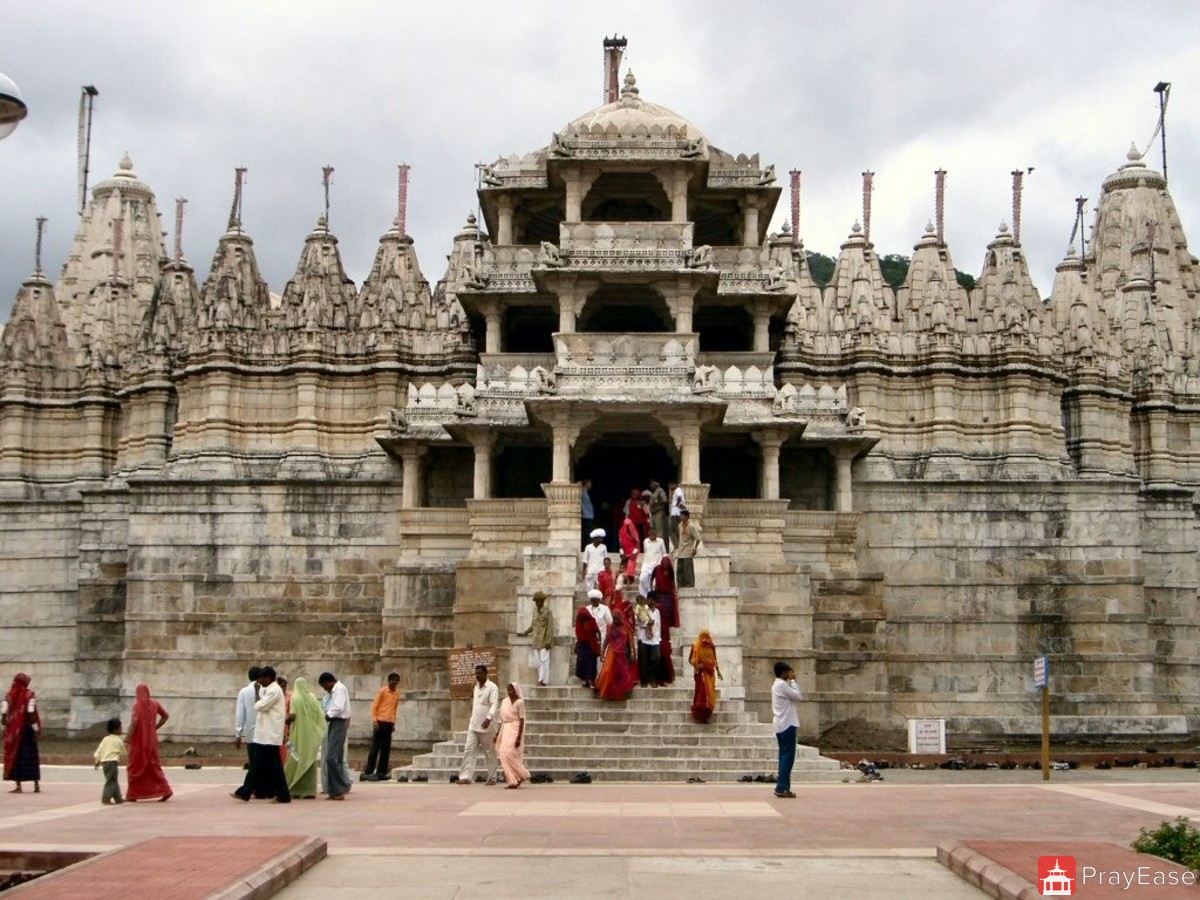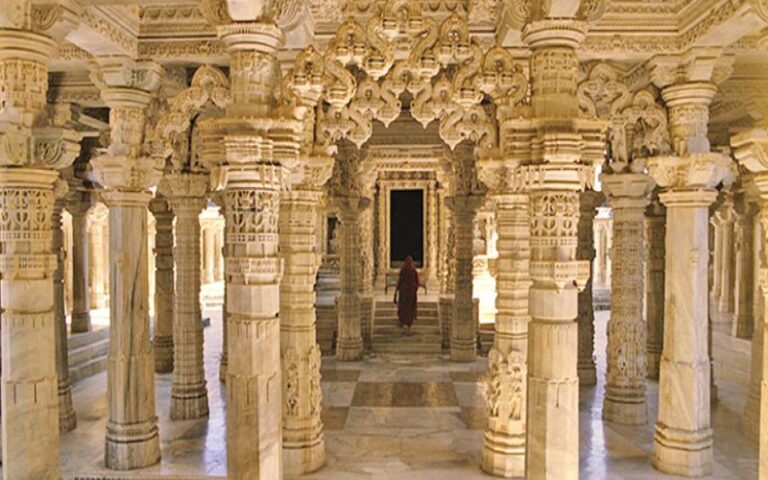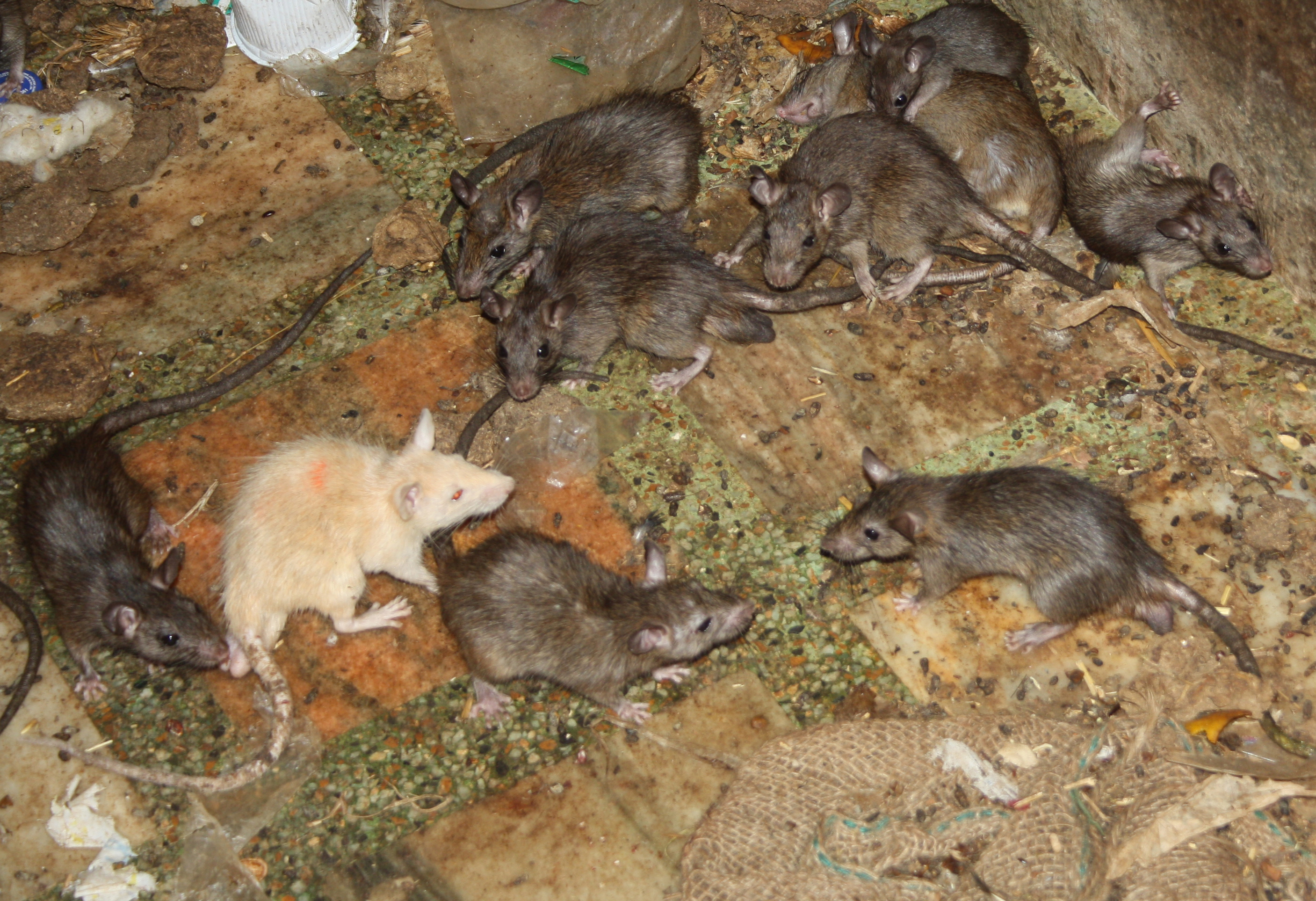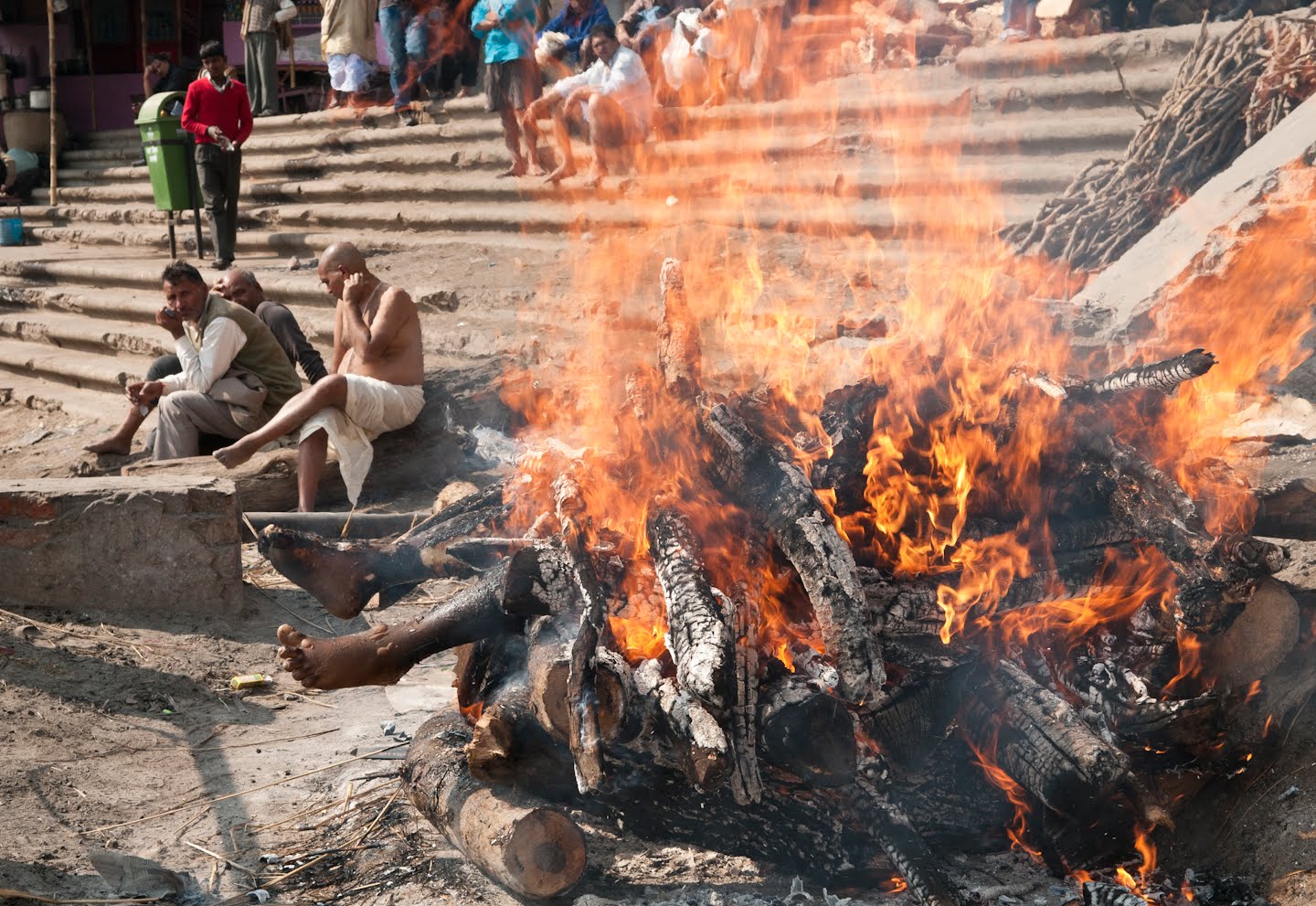These were some special temples in India
KALIGHAT KALI TEMPLE Kolkata. Dec 2012.
Regarded as one of the holiest of the 51 Shakti Peeths on Earth, the Kalighat Kali Temple is a must-visit place in Kolkata due to its history and legend. The temple is dedicated to the Hindu Goddess Kali and is located on the banks of Adi Ganga, a small canal that connects to the Hooghly River. The present temple building was built in 1809.
The idol of the Goddess Kali, featuring three big eyes, four hands and a long protruding tongue, is made of sandstone. The tongue and the eyes of the idol are made of gold.
The idol does not resemble the usual idols of the Goddess as it holds a scimitar, signifying the divine knowledge and a severed head of the demon king, Shumbha signifying the human ego slayed by the divine knowledge and removed from our behaviours. That is how one can attain moksha.
It is said that Shiva carried Sati’s burnt body while performing Tandav and various parts of the Goddess’s body fell on earth. The right toe of Sati fell at Kalighat and that’s where the temple was built. The presiding deity was Kalika, after whom, the city was named Kolkata.
Harkath Tala is located adjacent to Natmandir. There are two wooden bali-peeths for carrying out the bali or animal sacrifices. The bigger one is used for sacrificing bigger animals like buffaloes whereas, the smaller one for smaller animals like goats. The animals are sacrificed with a single stroke.
A tout took me first to the room where two young goats are slaughtered daily. The tout showing me around suggested a $50 donation for the poor which I’m sure is pocketed. When dealing with these guys always have some small change in your pocket and say that is all you have.
Pilgrims filed through smashing a coconut on the floor and drizzling the milk over the sacrificial site. The goat was restrained by grabbing both front legs and swinging them around the animal’s back causing the head to be held straight out. It is then placed in a U-shaped device and a bar is placed behind its head. A guy with a big sword then chops off its head. Wow. There was blood everywhere. A jostling pilgrim queue snakes into the main hall to fling hibiscus flowers at a crowned, black-faced three-eyed Kali image.
TIRUPATHI Tamil Nadu December 2012. Tirupathi is the busiest temple in the world. Forty million Hindus visit every year.
Arriving after 13 hours on the train at 7:30 am, I caught a bus one hour up the 17 km, switchbacking road to the top of the mountain and Tirupathi. Leaving my pack in luggage storage, I joined the darshan (fee) line for 300 rupees (~$6). I think they took pity on me. The people I joined had already been in line for two hours but didn’t mind me budding in. Feeling lucky with my great break, I was optimistic it would not be long. The free line was across a small lake in a cage of their own. Their route was longer than ours. It will take them twelve hours to reach the temple.
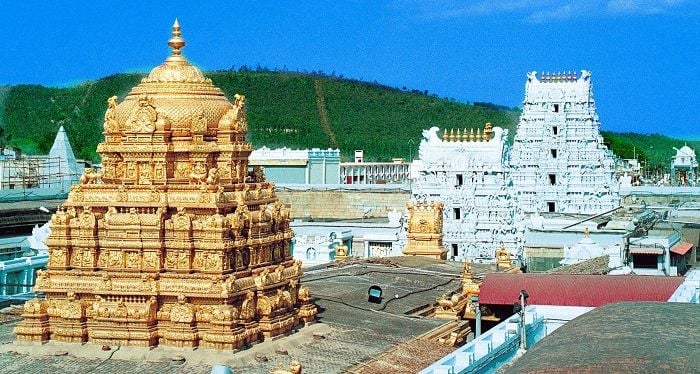
The Hindu religion has a pantheon of 33 million gods, one of which is Vishnu. Lord Venkateswara is believed by followers to be a very merciful form of Vishnu, being the fulfiller of every wish made to him by the devotees. This is important, as Hindu gods are viewed as being easily bribable. 1,500 years ago, the queen donated the 18-inch silver idol of Venkateswara to this sacred shrine. This idol is believed to be self-manifested, as there is no known sculptor possessing the capability to sculpt idols of god so proportionately. In addition, no human being is known to have installed it in the shrine. Over the centuries, coronations were held in the temple and it received many gifts of gold and jewels. It is now the second richest temple in the world (number one is in Kerala, India). Indians take their religion pretty seriously.
Many devotees have their head tonsured as an offering to God during their pilgrimage. The daily amount of hair collected is over a ton. The hair gathered is sold by the temple organization a few times a year by public auction to international buyers for use as hair extensions and in cosmetics, bringing over $6 million to the temple’s treasury. This is the second-highest income-generating activity in the temple.
The line soon entered ‘the cage’, a six-foot wide tiled sidewalk enclosed with iron bars and chain link fence that snakes through the town. With a solid metal roof and a crush of people, there is no escape.
Luckily bathrooms and emergency exits were occasionally accessible. A snack stand would have made a killing. I had one opportunity to buy some biscuits through the chain link fence. Snapping them up, I offered to share with everyone around me. They looked at me in very odd ways. Virtually no one accepted.
I was in physical contact with at least two others at all times. Many were shaven bald and kept feeling their head to remind themselves what they had done.
Travelling only about one kilometre, you can imagine how slow this was moving. The line once stood still for over 30 minutes. Amazingly, some families had small children. I talked to 3 young guys from Bangalore for a while but otherwise interacted with no one. None showed any interest in me and I don’t speak Hindi. This was not a relaxing time.
After five hours, it looked like we were getting close when we entered a building for the obligatory security check. Security checks are a fact of life in India. There is always a metal detector, but these are universally ignored. Baggage is passed through X-ray and everyone gets a thorough frisk. Two lines for everything – one for men, one for women. Cameras are confiscated. I was told at this point that I could not go in as I was wearing shorts. Upset, I pulled them down to cover my knees and they let me continue.
We then entered one of three large rooms and waited for an hour. Somebody stood up to go to the bathroom and the crowd stampeded for the exit producing a crush of people at the narrow door.
We then entered 4 connected rooms, each about 10×60 feet with a small doorway at each end. You can imagine what happened at the door. I was in contact with at least six others in the squeeze.
That led into a stairwell divided by a chain link fence to merge with the two-hour line. These people had booked at least one month previously for 50 rupees. I was jealous.
Then into another ‘cage’ and finally, after 7 fatiguing hours of shuffling along, we joined the free line inside the temple. Everybody was getting pretty excited.
Wonderfully carved stone pillars and gold shrines were passed. As we approached the shrine to the powerful Lord Venkateshwara, Priests shoved us along and I had about three seconds to view a tiny stick figure down a dimly lit 30-foot-long corridor!!!. Pushed away from the “view”, I joined other lines to other shrines, one to his mother and another frenzied line where priests held a silver cup to the top of the pilgrim’s head. Our reward was a cookie ball.
Outside was a big crowd relaxing after the ordeal. Everyone admired the gilded gold roof of the temple.
Open 22 hours/day, an average of 60,000 pilgrims come daily. But this was December 27 and most of India was on holiday. 200,000 blissed-out folks saw him on my day. I can’t imagine it when 500,000 visit. I guess it was worth it – certainly, it was amazing to see so many devoted people never complaining. Not surprisingly, I was the only Westerner I saw. Temple staff number 12,000 and the town has hundreds of apartment buildings.
Disorientated by the wandering route of the cage and intermediary buildings, I got lost trying to find my pack, but made it down to Tirumala by 6:30. Then I had a four-hour bus to Chennai (formally called Madras, pop 10 million,), the fourth largest city in India and, the capital of Tamil Nadu. I had only a small glass of chai and the biscuits I bought through the chain link fence to eat all day. It was late, I could only find a grungy room and stayed awake most of the night with mosquitoes.
SRI PADMANABHASWAMY TEMPLE, Trivandrum (900,000), the capital of Kerala. The temple is 30 m high with a 7-tiered gateway tower. The principal deity is Padmanabhaswamy, a form of Vishnu enshrined in the “Anantashayana” posture, engaged in eternal yogic sleep on his serpent mount, Shesha. In the inner sanctum, closed to non-Hindus, the reclining Panmanabha reclines on a serpent made from 10,000 stones brought by an elephant from Nepal. The 6-metre-long solid gold statue makes this the richest temple in the world.
The Padmanabhaswamy temple treasure is a collection of valuable objects including gold thrones, crowns, coins, statues and ornaments, diamonds and other precious stones. There are at least six underground vaults designated A, B, C, D, E and F. Vault B has not been opened since at least the 1880s. C, D, E, and F, are in the custody of the temple priests. and are opened at least eight times every year, some of the contents stored in them are routinely taken out for use on special ceremonial occasions. Vault A contains baskets, earthen pots, and copper pots scattered everywhere all containing valuable objects.
Some of the items found include A 4-foot (1.2 m) high and 3-foot (0.91 m) wide solid pure-golden idol of Mahavishnu studded with diamonds and other fully precious stones., A solid pure-golden throne, studded with hundreds of diamonds and precious stones, meant for the 18-foot (5.5 m) idol of the deity, Ceremonial attire for adorning the deity in the form of 16-part gold anki weighing almost 30 kilograms (66 lb), An 18-foot (5.5 m) long pure-gold chain among thousands of pure-gold chains, A pure-gold sheaf weighing 500 kilograms (1,100 lb), A 36-kilogram (79 lb) golden veil, 1200 ‘Sarappalli’ pure-gold coin-chains encrusted with precious stones weighing between 3.5 kg and 10.5 kg, Several sacks filled with golden artifacts, necklaces, diadems, diamonds, rubies, sapphires, emeralds, gemstones, and objects made of other precious metals, Gold coconut shells studded with rubies and emeralds, Several 18th-century Napoleonic-era coins, Hundreds of thousands of gold coins of the Roman Empire and An 800-kilogram (1,800 lb) hoard of gold coins dating to the medieval period. Most scholars believe that this was accumulated over thousands of years,
The temple has a corridor with 365 and one-quarter sculptured granite-stone pillars with elaborate carvings, an ultimate testimonial for the Vishvakarma sthapathis in sculpting this architectural masterpiece.
The deity is visible through three doors – the visage of the reclining Padmanabha and Siva Linga underneath his hand is seen through the first door; Sridevi and Bhrigu Muni in Katusarkara, Brahma seated on a lotus emanating from the deity’s navel, hence the name, “Padmanabha”, gold abhisheka moorthies of Padmanabha, Sridevi and Bhudevi, and silver utsava moorthi of Padmanabha through the second door; the deity’s feet, and Bhudevi and Markandeya Muni in Katusarkara through the third door.
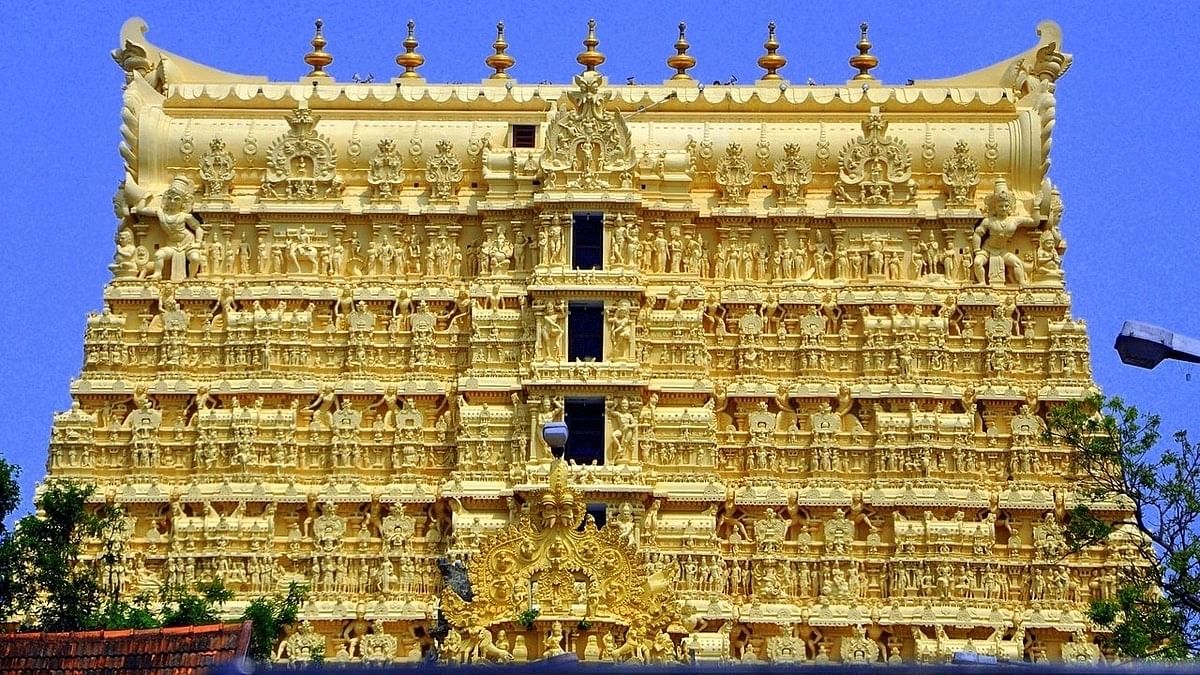
DELWARA TEMPLE Mt Abu (pop 22,000, elevation 1200 m), Rajasthan’s only hill station, sits among green forests on the state’s highest mountain close to the Gujarat border. Delwara is a not-to-be-missed Jain temple.
Dilwara temples consist of 5 temples of the same size and all are single-storied. 48 pillars in all the temples have the beautiful status of females in different dancing gestures. The main attraction of this temple is ‘Rang Mandapa’ which is in the dome-shaped ceiling. It has a chandelier-like structure in the middle of the roof, and the 16 idols of ‘Vidya Devi’, the goddess of knowledge, are made of stone surrounding it. The other designs of carvings include Lotus, gods, and abstract patterns, all of these ceilings, doorways, pillars, and panels have minutely carved ornamental details which shows its unique architecture. At that time there was no transportation system for such huge blocks of marble at 1200 meters in height. Elephants were used to transport white marble on their backs from Arasuri hills at Ambaji to Mount Abu.
It was built between 400 and 1000 years ago. With the best carving, all in marble, in India, the artisans were paid by the amount of dust they collected, encouraging them to carve ever more intricately. It is impossible to figure out how the carving was done without power tools – a Dremel would have been a great help here. Two of the five temples have dizzyingly intense carvings. Vimal Vasahi was started in 1031 and took 1500 masons and 1200 labourers 14 years to build.
Outside is the House of Elephants, featuring a procession of marble elephants that carried the marble to the site.
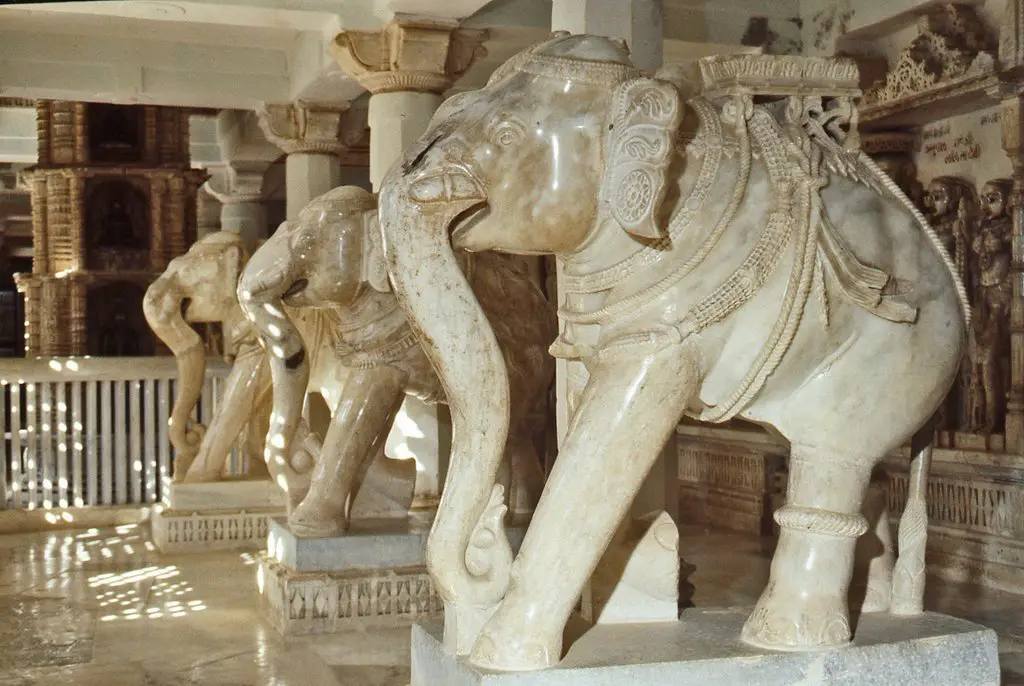
Inside, a forest of beautifully carved pillars surrounds the central shrine to Adinath, the main Jain god. The Luna Vasahi Temple is dedicated to Neminath, the 22nd leader, and was built in 1230 by two brothers.
The marble carving here took 2500 workers 15 years to create. Noted for its intricacy and delicacy, the marble almost becomes transparent and it is hard to believe that this huge lace-like filigree started as a solid block of marble. The ceilings were spectacular.
The tour continued to Ranakpur, one of India’s biggest and most important Jain temple complexes. The main temple, the Chaumukha Mandir, is dedicated to Adinath, the first Jain leader.


The temple is a complicated series of 29 halls, 80 domes and 1444 individually engraved pillars. Some of the huge domes have great carving but the intricacy does not match the Jain temple at Mt Abu.
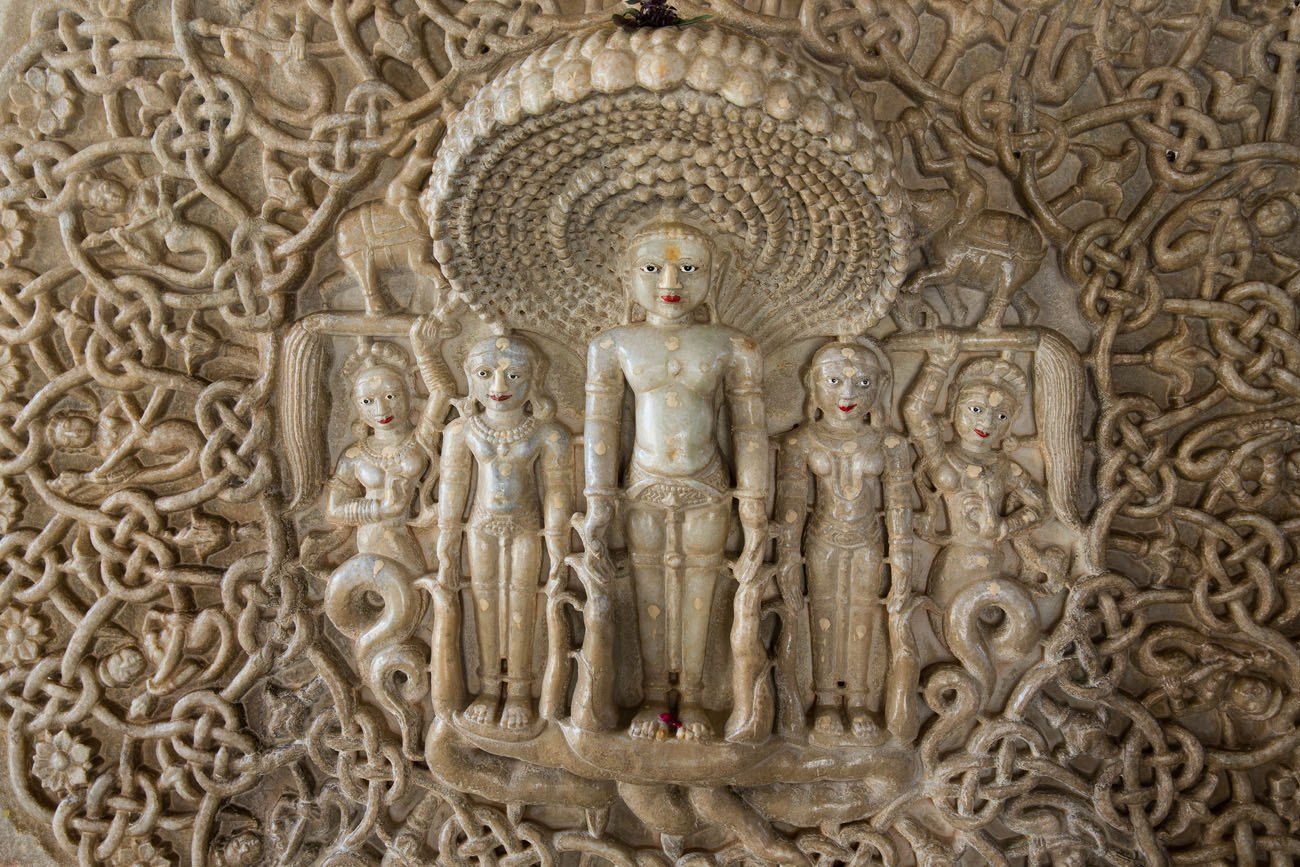

KARNI MATA TEMPLE Bikaner, Rajasthan February 2013
BIkaner’s main attraction is 30 km south of town. Karni Mata was the 14th-century incarnation of Durga, who in disagreement with Yama, the god of death, decreed that all members of the Yamas family would be reincarnated as rats. Extraordinary even by Hindu standards, the mass of holy rodents running around the temple is not for the squeamish. It’s considered auspicious to have one run across your feet and sighting one of the white rats (I did) also augurs well for your spiritual progress. The rats were fed grain and milk from huge bowls. You can only imagine how many there are when rats were allowed to produce at an unlimited rate.
F***ing crazy. One had to remove your shoes to enter and it was decidedly unpleasant to walk around with all the rat shit and grain on the floor.
India has all their animals upside down. The cow is the top dog, with snakes, monkeys and rats next and dogs at the bottom of the heap. To be reincarnated as a dog is the worst. Despite all this holy reverence, it seems that they abuse animals. People who can’t afford to feed their animals let them run loose and that is why garbage is a mainstay of food for cattle, goats, and dogs.
Outside of Bikaner, next to a normal garbage dump, hundreds of dead cows, most from intestinal obstructions from eating plastic, were deposited. The rotting bodies were being fed upon by packs of dogs! Holy cow!
VARANASI (pop 1.2 million) is the most important Hindu religious city in India and one of the longest continuously inhabited cities in the world (it was previously known as Kachi and then Benares). Dying here relieves one from continuing on the circle of life.
Old Town is a labyrinth of narrow allies too narrow for traffic. My hotel (Ganpati Guesthouse), is situated right above the river on Meer Ghat.
Varanasi sits on the west bank of a wide sweep of the Ganges, and ghats (stairs that end in the river) cover the entire shoreline. The ghats are covered in water during the monsoon and huge piles of sand remain to be cleaned off some of the stairs. Boats in the river have big diesel pumps to wash off the sand. At this time of the year, walk along the ghats and the unravelling spectacle that Varanasi is famous for. Festivals seem continuous in Varanasi and are held on the ghats. There are 412 festivals in India every day.
Many come here to bathe in the early morning for sunrise, to wash away the sins of a lifetime in the sacred, incredibly polluted water. People wash their clothes in it and despite the water, the clothes look clean. Most famously, they come to be cremated here. Dying in Varanasi offers ‘moksha’ or liberation from the cycle of birth and death, making the city the beating heart of the Hindu universe. It is a unique place and walking along the ghats will live long in your memory.
The only things not eligible for cremation are animals, people who are already pure (pregnant women, children under 10, and sadhus), people who have died from leprosy or smallpox (to avoid releasing the germs) and people killed by snakebite (snakes are holy). These are taken to the middle of the river, weighed down with stones and sunk. For the rest, cremation cleans their sins and their spirits are released into the air to go to heaven. There are two ghats where all the cremations take place and I watched the process for several hours at Manikarnika, the largest of the two.
The body is brought down to the river on bamboo stretchers, washed in the river and covered in a white cover by the family. Women are not allowed to partake in the process as they often throw themselves on the fire in remorse. The exact amount of wood is calculated and paid for (200 rupees per kg for sandalwood and 150 for banyan, about 200 kg is used in an average cremation) and a pyre is constructed from the huge piles of logs surrounding the ghat. Sandalwood powder is used to control the smell. Ghee and loose brush are used to fuel the initial fire. Fire is obtained with a big sheaf of grass from a fire burning continuously for 3500 years at this ghat. The head is crushed about 2 hours into the burn to release the spirits. The entire process takes about 3 hours. The ashes are collected and dumped into the river. Photographs are prohibited.
A pack of dogs and cows roam the ghat, a garbage dump for all the discarded clothing, stretchers, and typical garbage on the shore of the sacred river. 7 big boats filled with wood ready for unloading were on shore. The water is full of sightseers in rowboats viewing the spectacle. Many touts saunter up to you and begin to give all the above info. Even though you tell them that you donated money for wood for poor people the day before and have heard all they have to say and don’t plan on giving them money today, they persist with the info. If you leave and don’t pay (500 rupees or about $11 is suggested), they become incredibly aggressive, wondering why you just wasted an hour of their time. In reality, these bullies simply pocket the money. Indians have persistence down to a fine science.
The Vishwanath or Golden Temple, dedicated to Shiva, is the most famous temple in Varanasi.
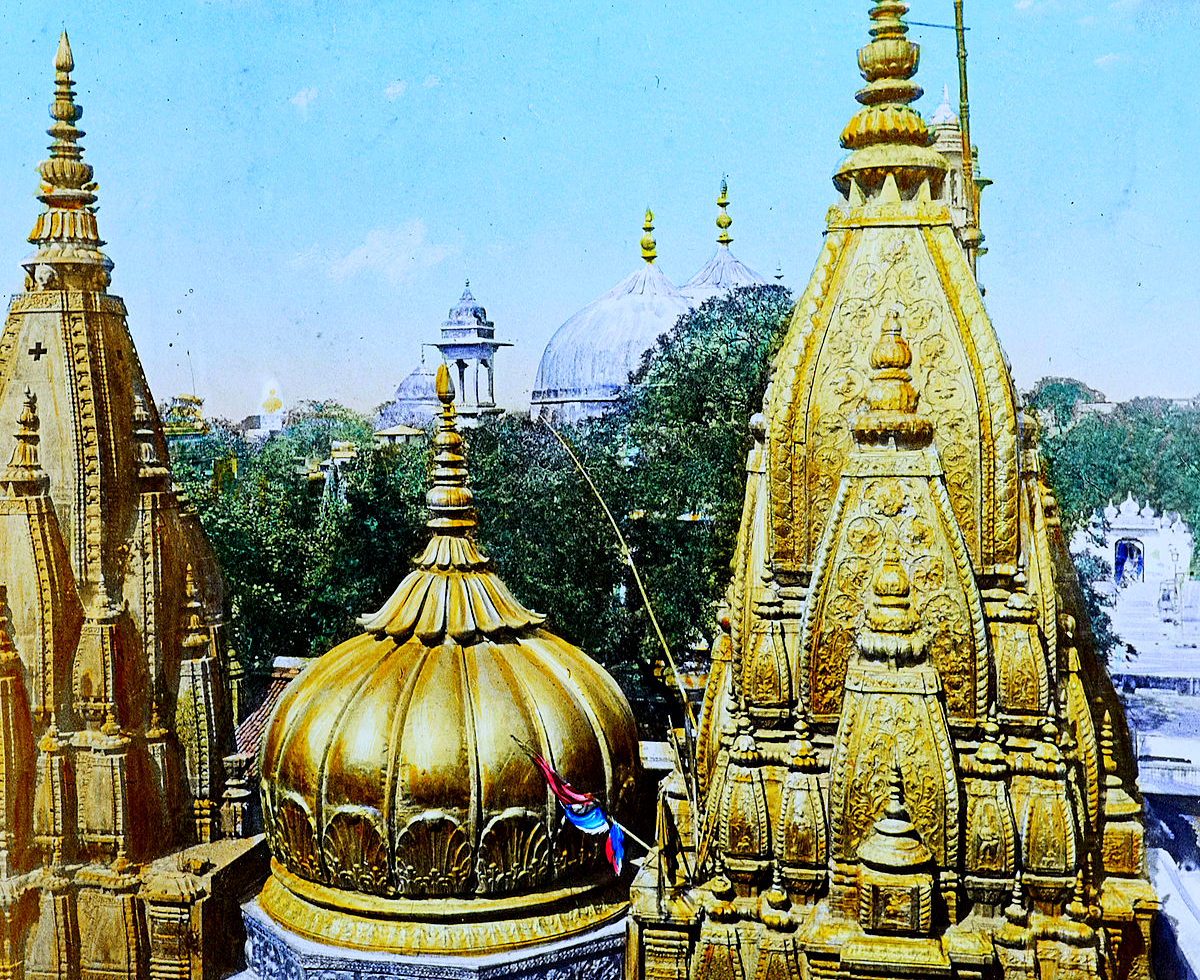
It has 800kg of gold plate on the tower and dome. Off an alley in Old Town, the entrance is an inconspicuous metal detector screener. If not for the crowds, long lines, offering sellers and army sitting around, one could easily miss it. One is frisked twice on entry. Non-Hindus are not allowed in but surprisingly I just breezed through. Joining one of two lines, it was a frantic frenzy to touch the small lingam, what all the fuss was about. It was a 10″ diameter stone, 12″ high, with a rounded top. A big copper jug of water suspended above drizzled water over it. Everyone had a small jug of water and a basket with marigolds and a candle as offerings. A lingam is the phallic representation of Shiva.
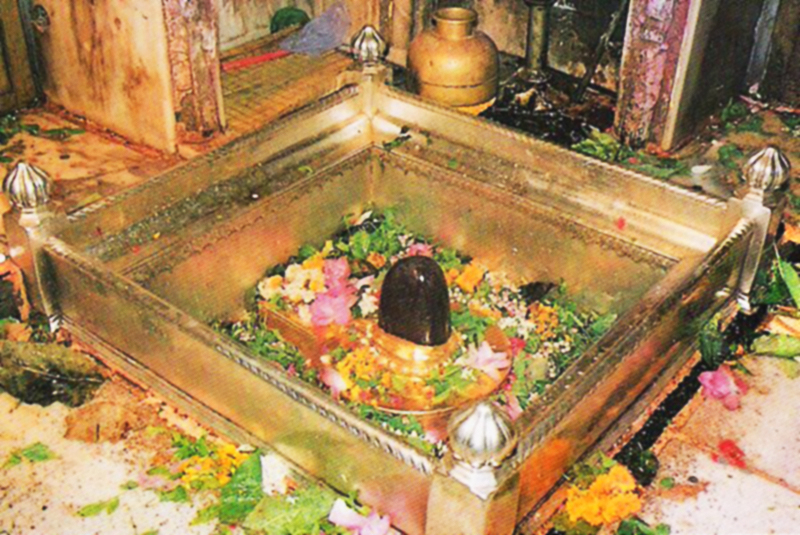
I am often up at 5:30 to watch the bathers in the ghat from the many balconies of my hotel. The nearby Hindu temple rings a bell endlessly and blows a conch shell just before the sun rises as a red orb directly across the Ganges. A huge sandbank stretches for a few kilometres on the flood plain and a line of trees hides the town of Ramnagar. Nothing interferes with the view of the rising sun. Touts wander around the ghat selling boat rides. The river is packed with tourist row boats. Flotillas of candles in baskets with marigolds are released. The boats are one of the obligatory tourist activities but I have resisted.
For those who want to purify themselves in the Ganges in Varanasi, here is something that might make you think twice. Only 8 of 3000 municipalities in India treat their sewage. This is an excerpt from the book The Big Thirst, about how India treats its holy rivers, specifically how Delhi disposes of its sewage.
Just north of the City of Delhi, the Yamuna River is wide and flat and peaceful, winding through undeveloped land, with a scattering of people. The river is not pristine, but it has an appealing naturalness.
Near Delhi is a low dam across the Yamuna, and just behind the dam, Delhi has a water intake to supply drinking water to the thirsty city of 20 million people. Almost no water passes beyond the dam, the Yamuna is reduced to a trickle, not even 10% of the river’s width above the dam. For perhaps 150 feet, the mighty and revered Yamuna River is little more than a creek. Then, all at once, the river’s flow is restored from the west bank – a vast cataract of water comes rushing in from the mouth of a tributary that is 60 feet across, and if you close your eyes, the volume and the sound of crashing water are such that you can imagine a wilderness river.
But the smell and the colour of this tributary are astonishing. The water is India-ink black. The smell is barnyard-organic fermented with chemical plant acrid – manure and methane. Where the black tributary joins the Yamuna’s riverbed, the smell is too strong to bear.
This is one of the “drains” that collect the wastewater from Delhi’s residents, its hospitals, factories, and businesses, and pours it back into the Yamuna, almost a billion gallons a day. It is, in fact, a black river of raw urban sewage – this one drain puts out 1 million gallons of wastewater every four minutes. Out in the middle of the restored flow floats the carcass of a dead water buffalo; along the banks, you can easily spot every sort of debris – flowers, clothing, take-out food containers, a Bacardi rum bottle, a hypodermic needle.
Just beyond where that first canal of sewage empties into the riverbed, there is an informal beach, where people come to make sacred offerings. You can rent a boat and float out onto the black river. The smell eventually dulls the nose. The surface of the Yamuna is odd – it’s flat and shiny black but pocked everywhere with tiny bubbles fizzing up, from methane bubbling up from the fermenting river.
People at the beach wash clothes in this water, people come to take a dip in the Yamuna’s sacred flow, to wash away their sins, as if anything they have done could be cleansed by water this dirty. It’s not wise to even put your hand in the water. It is unimaginable, almost immeasurably, filthy.
In 2008, India’s Centre for Science and Environment reported that as the Yamuna flows through Delhi, the pollution isn’t just unsafe for swimming. India’s standard for safe swimming is 500 bacteria per 100 millilitres (the US EPA standard is half that.) Halfway along its trip through Delhi, the coliform count was typically 10 million bacteria per 100 millilitres and often 100 million. One eyedropper of Yamuna River water is enough to make 6 bathtubs of water unsafe to sit in.
The Yamuna flows for fourteen miles along the eastern side of Delhi, mostly hidden from easy public access, or even view. By the time the river leaves the city limits, twenty-two drains have emptied into it. The Yamuna just gets dirtier as it goes. The venerated Ganges River is, if conceivable dirtier, and the Yamuna is the main tributary of the Ganges, contributing 60% of its flow.
It’s easy to get discouraged about water in India and the Yamuna is typical. It’s hard to imagine, in a country that can compete in brain jobs with the United States, that can send science missions to the Moon and put six billionaires among the 50 richest people in the world, it’s hard to believe that it treats its great rivers this way.
But Delhi was able to eliminate air that was turning into a toxic soup from pollution by legislating the conversion of all public buses, taxis, and auto-rickshaws to low-emission compressed-natural-gas fuel. The air is still gray and smoky but much cleaner than without this measure.
One in six people in India rely on water that is transported by foot. Poor Indians don’t have the power to demand improved water service.
I left Varanasi on November 28th, 36 hours into one of Varanasi’s biggest festivals. Over these four days, permanent absolution from all sins is given if one bathes in the Ganges. Four million people are expected and many were up most of the night. Up at 5, I walked down to the ghat and it was a bedlam of undressing and sudsing, a regular bathathon. Tonight at sunset will be chaos.

